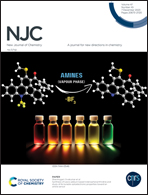Modulating the antibacterial activity of a CuO@HKUST-1 nanocomposite by optimizing its synthesis procedure†
Abstract
The loading and encapsulating of functional antibacterial agents on the surface or into the well-ordered pores of metal–organic frameworks (MOFs) effectively decreases their aggregation, leading to their increased contact with bacteria, thus enhancing the antibacterial performance. In this study, HKUST-1 was investigated to investigate the antibacterial activity of MOFs that have metal oxides in their pores (CuO@HKUST-1). HKUST-1 was synthesized via a solvothermal reaction and [Cu(CH3COO)2·H2O]0.47@HKUST-1 was synthesized through the immersion of HKUST-1 in an aqueous solution of Cu(CH3COO)2·H2O. Then, two [CuO]0.87@HKUST-1 and [CuO]0.65@HKUST-1 nanocomposites were prepared via the thermal treatment of HKUST-1 and [Cu(CH3COO)2·H2O]0.47@HKUST-1 at 295 °C and 290 °C under a N2 atmosphere, respectively. FT-IR, PXRD, TGA, ICP-OES, FE-SEM and EDS mapping analyses proved the successful synthesis of these compounds. Finally, the antibacterial activity of the nanocomposites was investigated against Gram-positive (S. aureus) and Gram-negative (E. coli) bacteria.



 Please wait while we load your content...
Please wait while we load your content...